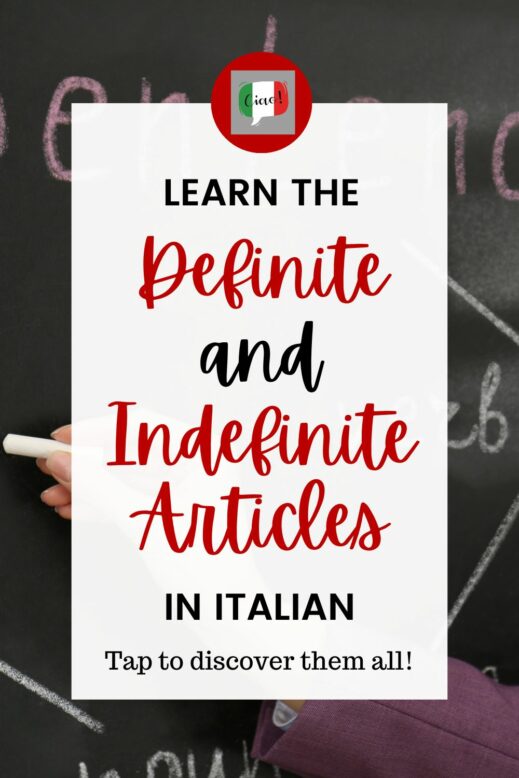In Italian, articles accompany nouns and indicate whether they are a) masculine or feminine (gender) and b) singular or plural (number). In Italian grammar, there are definite articles (il, lo, la, l’, i, gli, le) and indefinite articles (un, una, uno, un’) .
In this article, you’ll learn the difference between Italian definite and indefinite articles and when to use them correctly. Let’s begin!

The Definite Articles in Italian
A definite article is a determiner “that indicates that a noun refers to a specific thing or to something that has been identified previously.” Source: Thesaurus In English, there is only one definite article – ‘the‘ – whereas in Italian, there are seven.
In order to decide which definite article to use, you first need to figure out three things:
a) the first letter of the noun it modifies
b) the gender of that noun
c) whether the noun is singular or plural
Singular definite articles in Italian
il – masculine singular definite article
This article is used for any singular masculine noun that does not begin with a vowel, z, s + another consonant, gn, pn, ps, x or y.
- il libro = the book
- il treno = the train
- il mare = the sea
- il bambino = the boy
lo – masculine singular definite article
This article is used for any singular masculine noun that does begin with z, s + another consonant, gn, pn, ps, x or y.
- lo zaino = the backpack
- lo sgabello = the stool
- lo xilofono = the xylophone
- lo gnomo = the gnome
la – feminine singular definite article
This article is used for any singular feminine noun that does not begin with a vowel.
- la sedia = the chair
- la scatola = the box
- la TV = the TV
- la bambina = the girl
l’ – masculine and feminine singular definite article
This article is used for any singular masculine or feminine noun that begins with a vowel.
- l’albero = the tree (masculine)
- l’ape = the bee (feminine)
- l’elefante = the elephant (masculine)
- l’oca = the goose (feminine)

Plural definite articles in Italian
i – masculine plural definite article
This article is used for any plural masculine noun that does not begin with a vowel, z, s + another consonant, gn, pn, ps, x or y.
- i libri = the books
- i cuscini = the cushions
- i tavoli = the tables
- i papà = the dads
gli – masculine plural definite article
This article is used for any singular masculine noun that does begin with a vowel, z, s + another consonant, gn, pn, ps, x or y.
- gli zii = the uncles
- gli amici = the friends
- gli zaini = the backpacks
- gli gnocchi* = the dumplings
*Note: in colloquial Italian, depending on the region, you may hear different articles for certain words. One of the best examples is gnocco, which should technically be used with lo and the plural gli. However, you can hear Italians say il and i instead, most famously in the idiomatic phrase Ridi, ridi che la mamma ha fatto i gnocchi! (lit. Laugh, laugh because mom made gnocchi!).
That said, you shouldn’t worry too much about this. The best thing for learners is to stick to the official grammar rules.
le – feminine plural definite article
This article is used for any plural feminine noun.
- le mele = the apples
- le zebre = the zebras
- le finestre = the windows
- le amiche = the (female) friends

In this example, the preposition su (on) and the article gli become one word.
The Indefinite Articles in Italian
An indefinite article is a determiner that “refers to a noun without specifying it or refers to a noun to introduce it for the first time.” Source: Thesaurus In English, there are two indefinite articles – ‘a‘ and ‘an‘ – whereas in Italian, there are four.
The article you use depends on a couple of factors: the first letter of the noun it modifies, and the gender of that noun.
un – masculine singular indefinite article
This article is used for any singular masculine noun that does not begin with z, s + another consonant, gn, pn, ps, x or y.
- un albero = a tree
- un libro = a book
- un divano = a couch
- un amico = a (male) friend
uno – masculine singular indefinite article
This article is used for any singular masculine noun that does begin with z, s + another consonant, gn, pn, ps, x or y.
- uno zaino = a backpack
- uno yo-yo = a yo-yo
- uno sbaglio = a mistake
- uno psicologo = a phycologist
una – feminine singular indefinite article
This article is used for any singular feminine noun that does not begin with a vowel.
- una zebra = a zebra
- una sedia = a chair
- una macchina = a car/machine
- una bottiglia = a bottle
un’ – feminine singular indefinite article
This article is used for any singular feminine noun that does begin with a vowel.
- un’amica = a (female) friend
- un’oca = a goose
- un’epoca = an era
- un’isola = an island

What about plural indefinite articles? Quite simply, they don’t exist! Instead, Italians use the partitive articles: del, dello, della, dei, degli and delle.
- del pane = (some) bread
- dello zucchero = (some) sugar
- della pancetta = (some) bacon
- dei fagioli = (some) beans
- degli amici = (some) friends
- delle amiche = (some) female friends

Heather Broster is a graduate with honours in linguistics from the University of Western Ontario. She is an aspiring polyglot, proficient in English and Italian, as well as Japanese, Welsh, and French to varying degrees of fluency. Originally from Toronto, Heather has resided in various countries, notably Italy for a period of six years. Her primary focus lies in the fields of language acquisition, education, and bilingual instruction.


